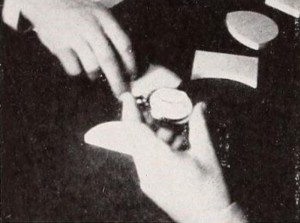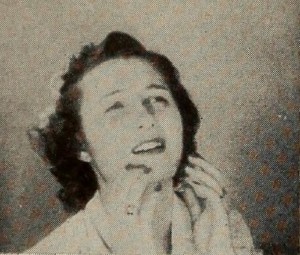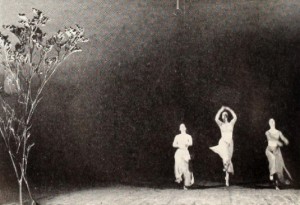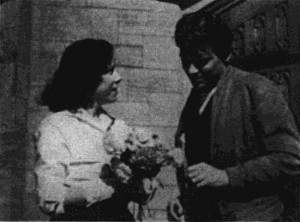"The Workshop trains physically handicapped people over school age. Activities featured are the General Committee at work - ladies seated around a table; a medical inspection - boys are weighed and have their chests, throats and limbs examined; all stages of book - binding; dinner time in the kitchen and the canteen; recreation; table - tennis, cards, reading, sewing, bagatelle, etc; needlework and embroidery room - women sewing at a long table; more scenes in the bindery; men busy in a leather workshop; and finally (in colour) a display of finished goods, and groups of workers, outside in the yard." (NWFA Online Archive)
"Ahead, Inc. depicts the movement in Flint, Michigan, to assist the handicapped in earning their own way in the world" PSA Journal, Sept. 1966, 34.

"In order to acquaint medical students with actual mental types observed in basic years of study, Jon B. Goldsborough has made Clinical Types of Mental Deficiencies. The film is not planned as an exhaustive study of types, but rather as a way to direct attention to symptoms and expressions in mental cases by showing specific examples of the diseases studied. The picture proceeds in an intelligent, orderly fashion, by bringing each definite type to the screen preceded by a simplified case history and the name of the specific disease. The film is marked by precision, clarity and intelligent planning and editing. Mr. Goldsborough has accomplished admirably his purpose of making a direct teaching aid, to be used in conjunction with extended commentary and lecture in the field of psychology and psychiatry." Movie Makers, Dec. 1944, 495.
"Curt is the story of a blind college student and the world in which he must live. Although he puts on a brave front, his problems exist and he must take them in stride. Dennis Thomas, who produced the film, brings his character to the audience, breathing life into him so effectively than long after the film is through one has a feeling for Curt and his world. The black-and-white photography is excellent throughout and the pacing shows an excellent knowledge of the mechanics of editing. This film well deserves the Student Film Award it received" PSA Journal, Sept. 1964, 50.

"Maxine Messner, who began her career before her uncle's camera in 1948 with Maxine's Big Moment, has very probably ended it in Dark Interlude. Well, it was a career which began happily — with the simple elation of a school girl's first formal date. And it is one which now ends happily — with marriage. But in the course of this final production it was touch and go whether our heroine would achieve this happiness. For in Dark Interlude William Messner has asked his niece to play a young lady struck down — only temporarily, as it turns out — by blindness. It is a role which she discharges with a moving simplicity and honesty — as, in fact, do those who play her father and her sweetheart. And Mr. Messner brings to their aid superb camera work and delicately luminous dramatic lighting. Unfortunately, however, the development of his basic theme does not match in simplicity and clarity either the film's playing or its production values." Movie Makers, Dec. 1953, 334.

'In Fancy Free' is a fantasy, imaginatively planned, photographed, and edited, which pictures the day-dreams of a young woman as she sits by the window looking out on her garden. Nearby objects, such as a Buddah, a porcelain figure of a dancer, a flower, and the passing of friends by her house set her to reflecting on her greatest wish -to be a dancer. She becomes absorbed in these dreams as a participant and the dances she imagines are laid against colorful and symbolic backgrounds. As the picture unfolds, narration by a young woman with a remarkable appealing voice tells the story of the young girl's desires, and then in the closing sequence, we learn in a brief heart-tugging climax that the girl, a cripple, can never take part in the activities of her dreams. The production is replete with effect lighting and special photographic effects -a forte which Turner ably established in his earlier productions. The dance numbers demanded skill, both in direction and execution; and the musical score, especially prepared by members of the student orchestra of the college where Turner is an instructor, is a vital and moving contribution to the picture." American Cinematographer, May 1952, 222.
"Save for a few opening and closing scenes, In Fancy Free is creative film fantasy of the highest order. For in it Glen H. Turner, beginning only with an idea, has evoked from his own mind and heart and spirit a superb and moving visual drama. As with all truly great art, the theme of In Fancy Free is essentially simple. At the film's opening a grave and tranquil girl is seen seated by a sunny window overlooking a rose garden. Laying aside her book amid these halcyon surroundings, she daydreams to herself of that which in all her life means most — the joys of dancing. There follow then four sequences of modern ballet, their themes suggested by objects or activities around her — an Oriental figurine, a string of paper dolls, a tennis game and the sunny, nodding roses. As these ballets end, we learn — in a brief, throat-tightening climax — that never, in her lifetime, can the girl take part in them. Although thematically quite different, In Fancy Free is a direct descendant of One Summer Day, with which (on 8mm. film) Mr. Turner won the Maxim Memorial Award in 1949. For in both fantasies the producer has, with sound dramatic instinct, related his world of pulsing wonder directly with the world of poignant reality. Thus it is that Mr. Turner's brilliant creative imageries take on a meaning above and beyond their mere technical virtuosity. The story development, dance themes, abstract settings and, needless to say, the camera work of In Fancy Free are all original creations by the producer. Mr. Turner enjoyed, however, a wealth of heart-warming collaboration in bringing this picture to its full flowering. An assistant professor of art at Brigham Young University, he was able to enlist the enthusiasm of countless other creative spirits. Thus it was that an original and brilliant musical score was written directly into this film dream. Thus, too, that this music was performed for recording by the university orchestra and that the dance themes were developed, almost step by step with the picture's progress, by the college ballet group. There will be those among the carping who are sure to complain that with this cooperation and those resources any amateur could produce a winner. To these few our unequivocal answer is "Non-sense!" Great art is created by the mind and heart of the artist — not by the hands of those who help him. That Mr. Turner could integrate these efforts into his own filmic concept is only another measure of this man as a truly creative cine artist." Movie Makers, Dec. 1951, 392-393, 410.

"Victor E. Pye, using his family as the principal actors in a sincere and competent photoplay, brings us the flavor of family life in far away Australia. With a sure cinematic sense, he opens Inspiration with a moving dolly sequence which carries you into the house directly to the star of the film. With creditable economy of footage and compelling acting and directing, Mr. Pye tells a simple tale of a once crippled child returned to health through the inspiration of a famous figure skater — herself a former "polio" victim. There are also several scenes from which it becomes obvious that the movie maker has profited from viewing theatrical productions with his mind on his own filming. Suave and sensitive, Inspiration becomes moving and believable as the plot unfolds." Movie Makers, Dec. 1946, 488.
"The Magic Bottle is a fantasy type of story with real life people acting out the parts. A crippled girl attending a beach party is seen by a drunk who, upon finding a lone bottle in the sand, is told that by finding the bottle he may have one big wish. His wish - that the girl may once more walk again" PSA Journal, Sept. 1966, 35.

"Some may seek the life of the sea to get away from something. But in the world of this deaf-mute, a deckhand on a salvage tug, there is generated a desire for companionship. In this simple story there are touching events along with the carnival atmosphere. A fine presentation in which one may feel for the mute and share his moments of happiness" PSA Journal, Nov. 1959, 48.
"A New Life for Jennifer is the sensitive story of a little girl about 4 years of age who is hard of hearing. She is enrolled in a special school for hard of hearing children where she learns to talk and speak correctly and in other ways to manage herself. The techniques used in theses teaching processes are emphatically depicted, and the judges did well in awarding to the maker of this film a citation which reads "For Special Service in the Public Interest" PSA Journal, Sept. 1965, 51.
Total Pages: 2